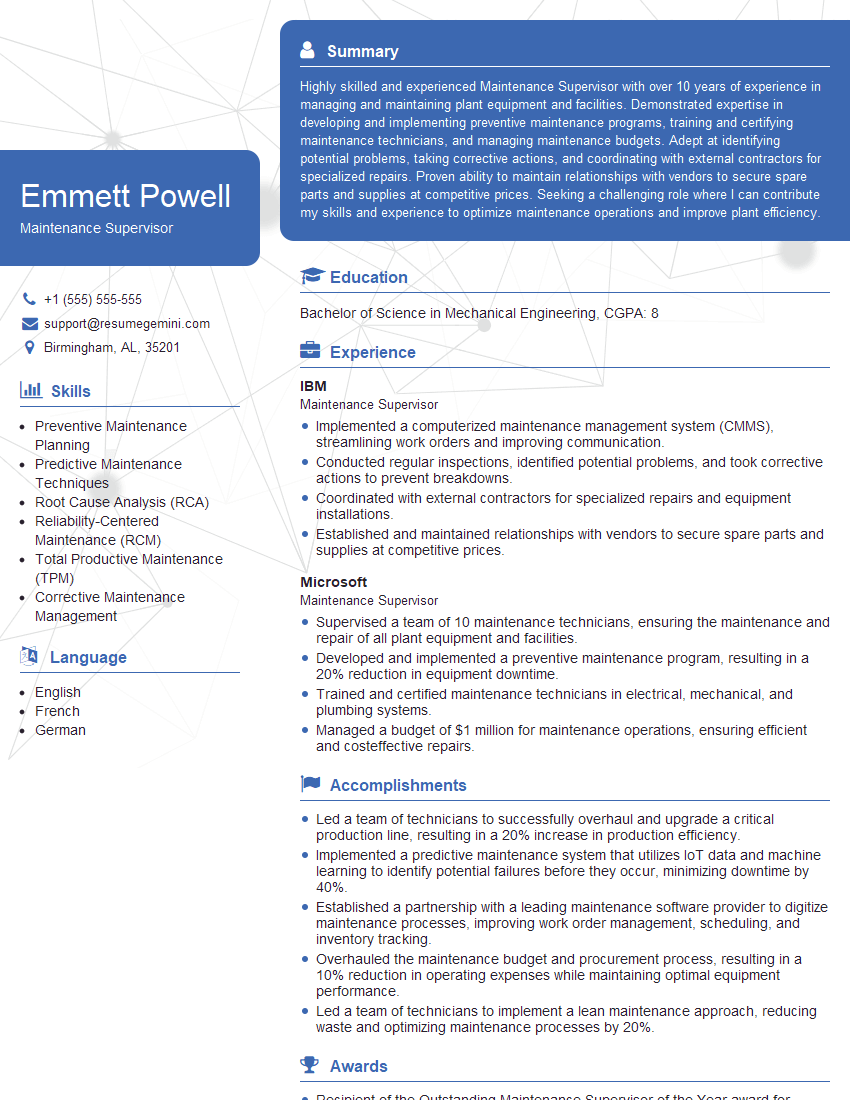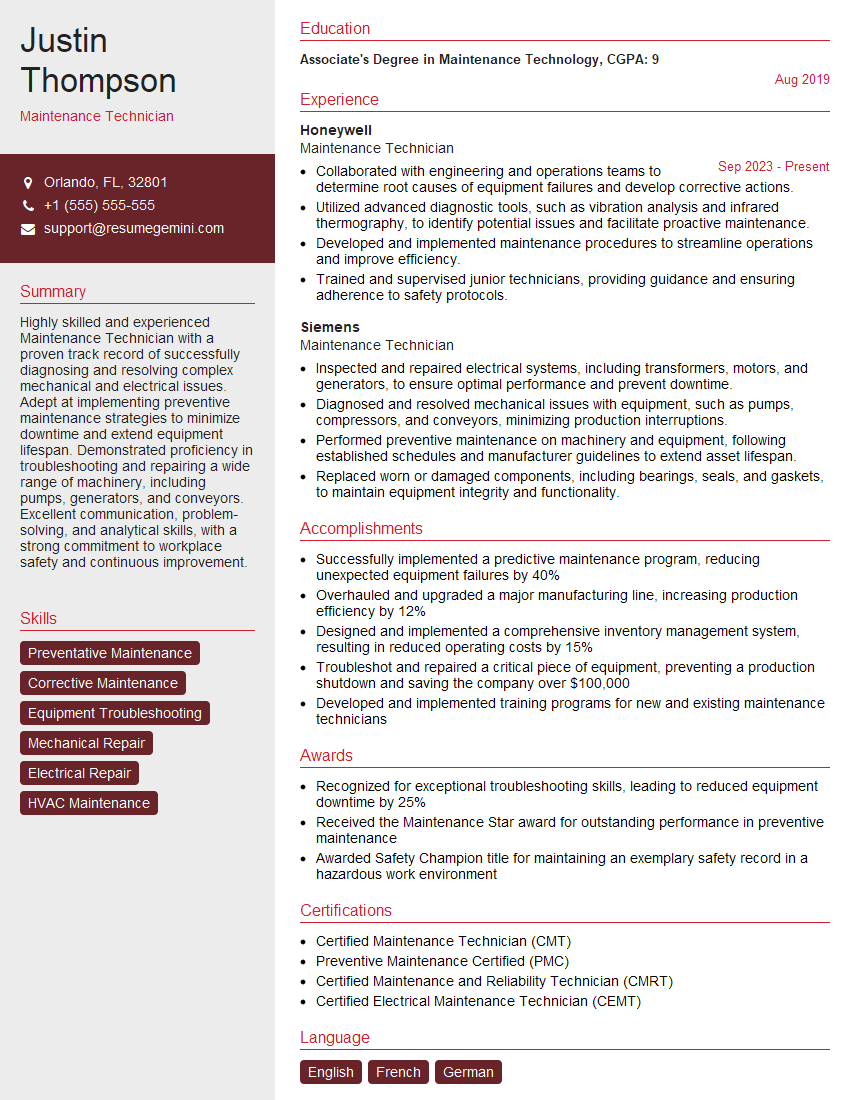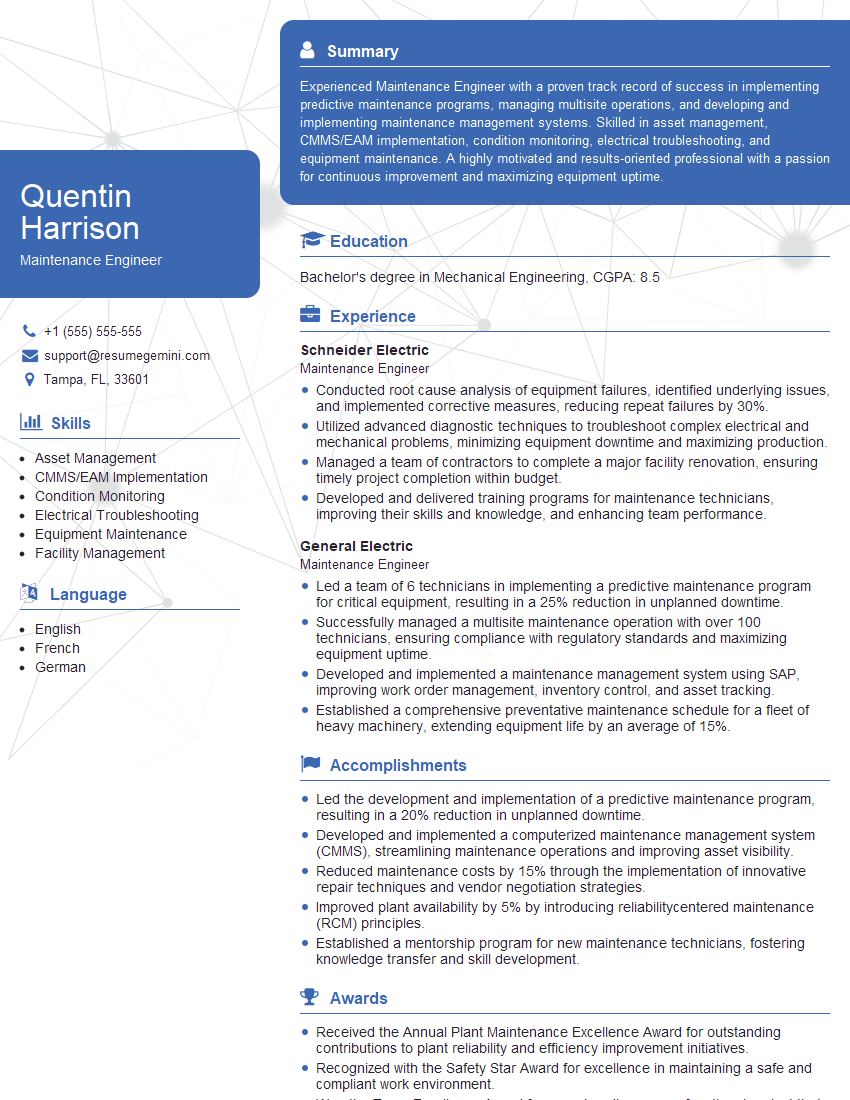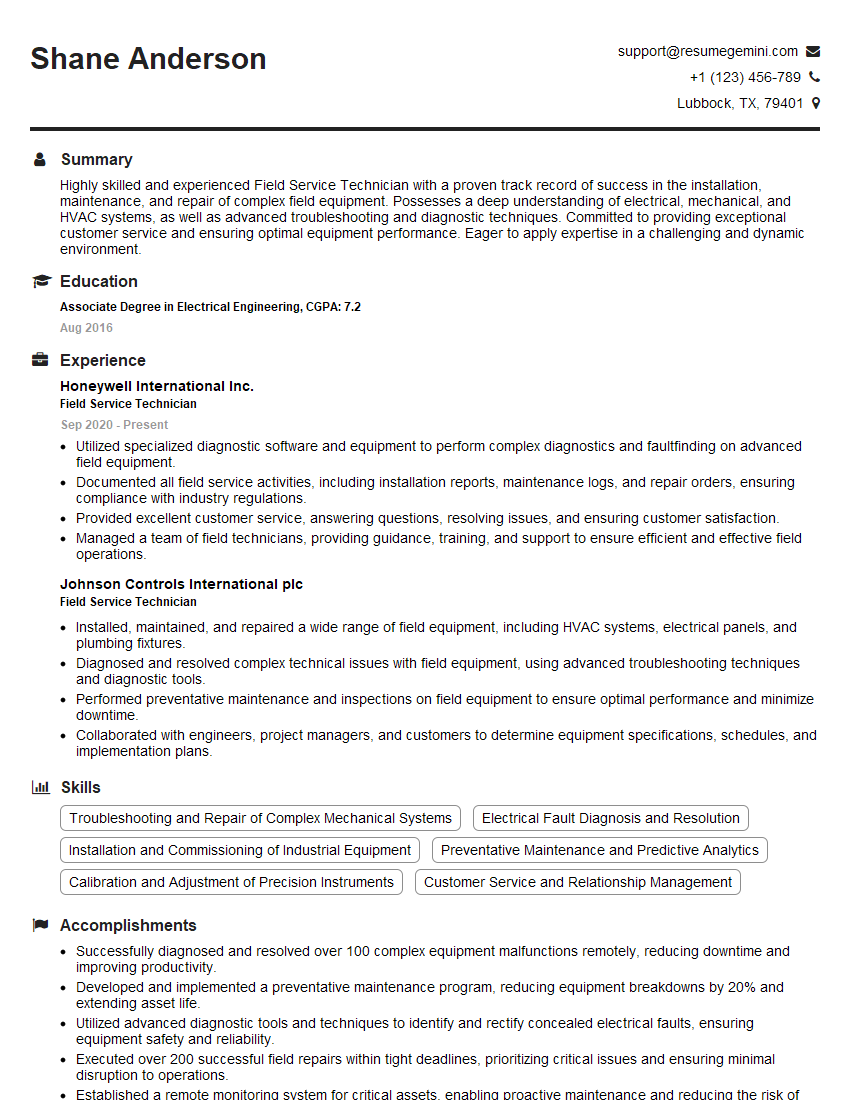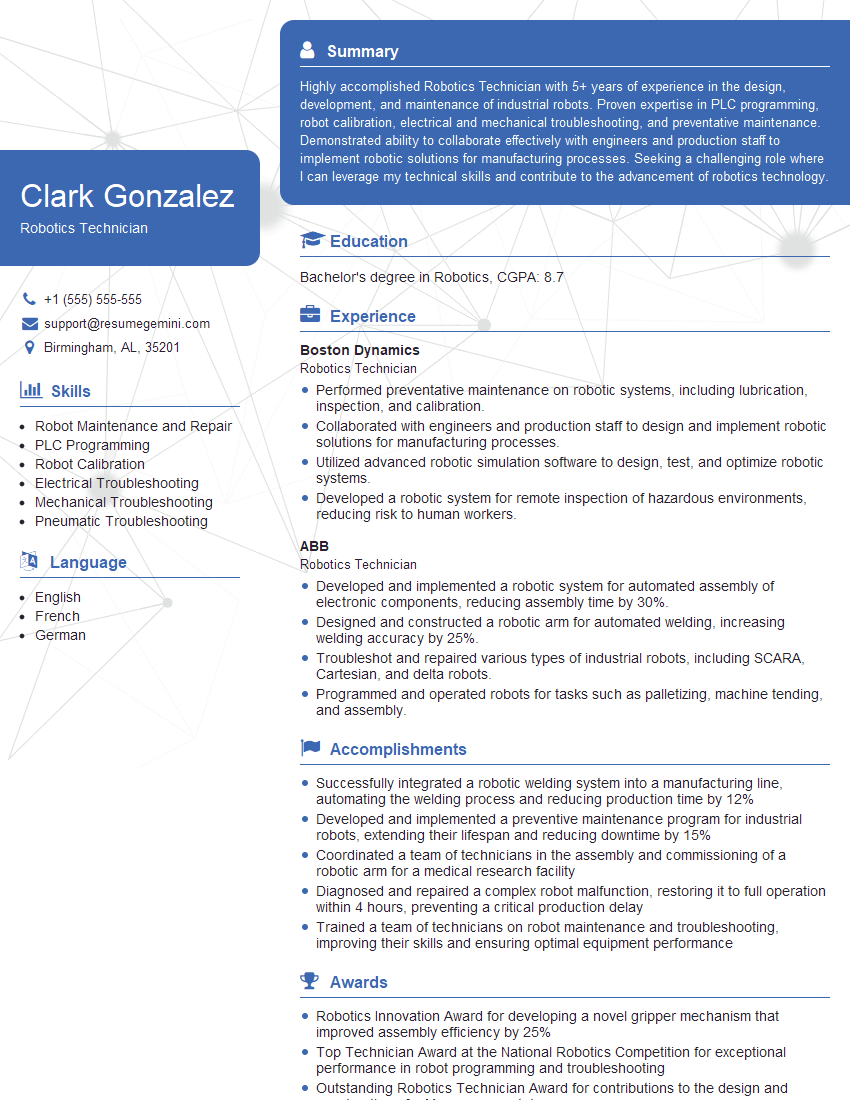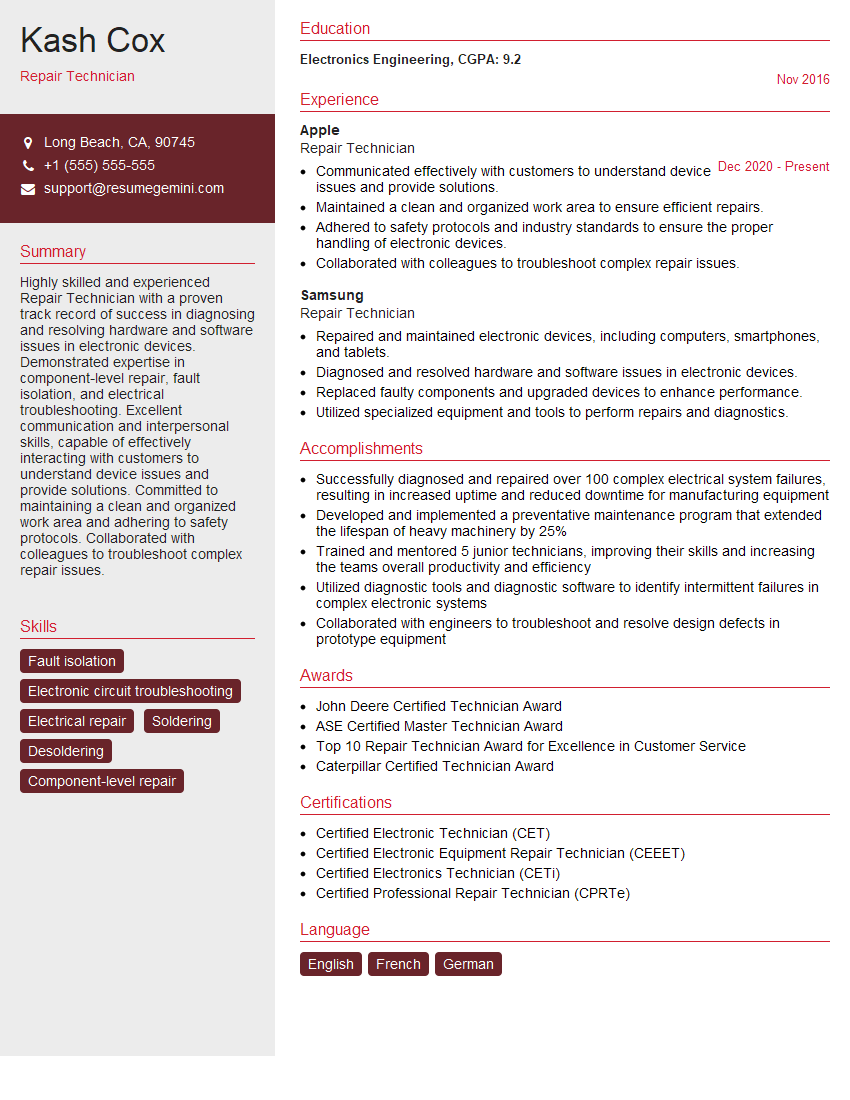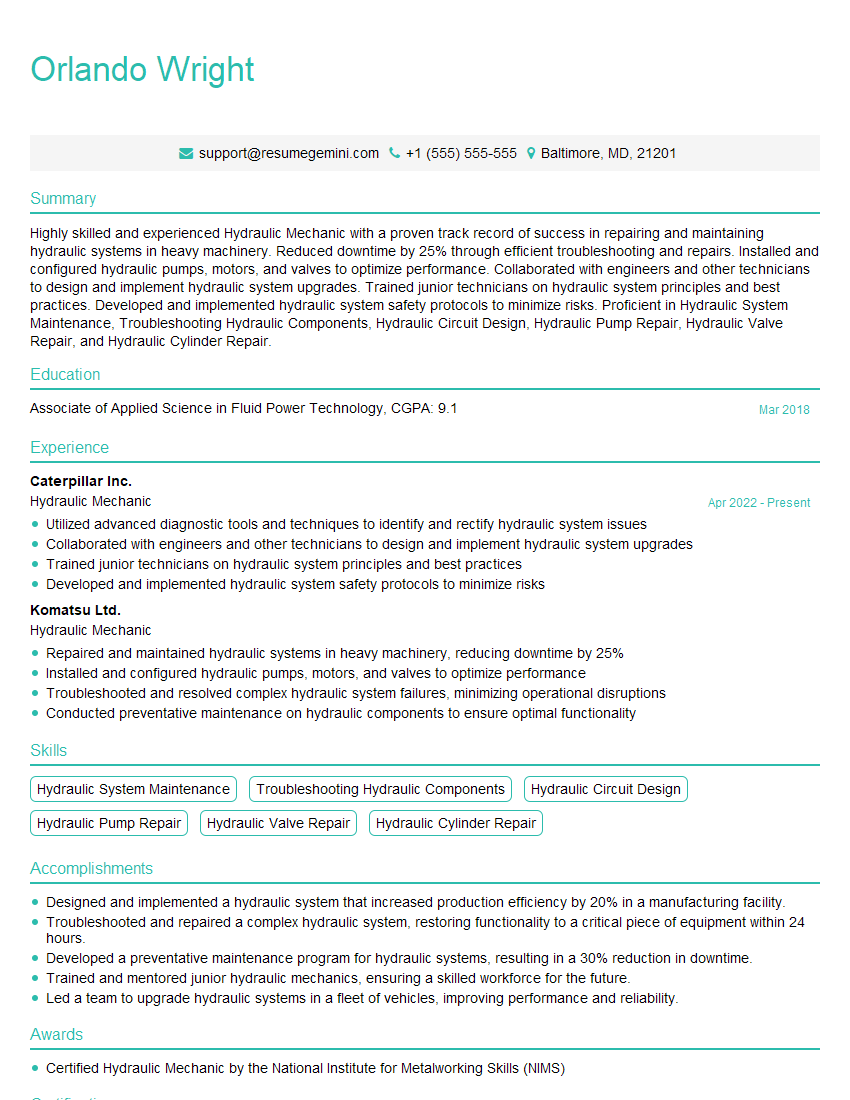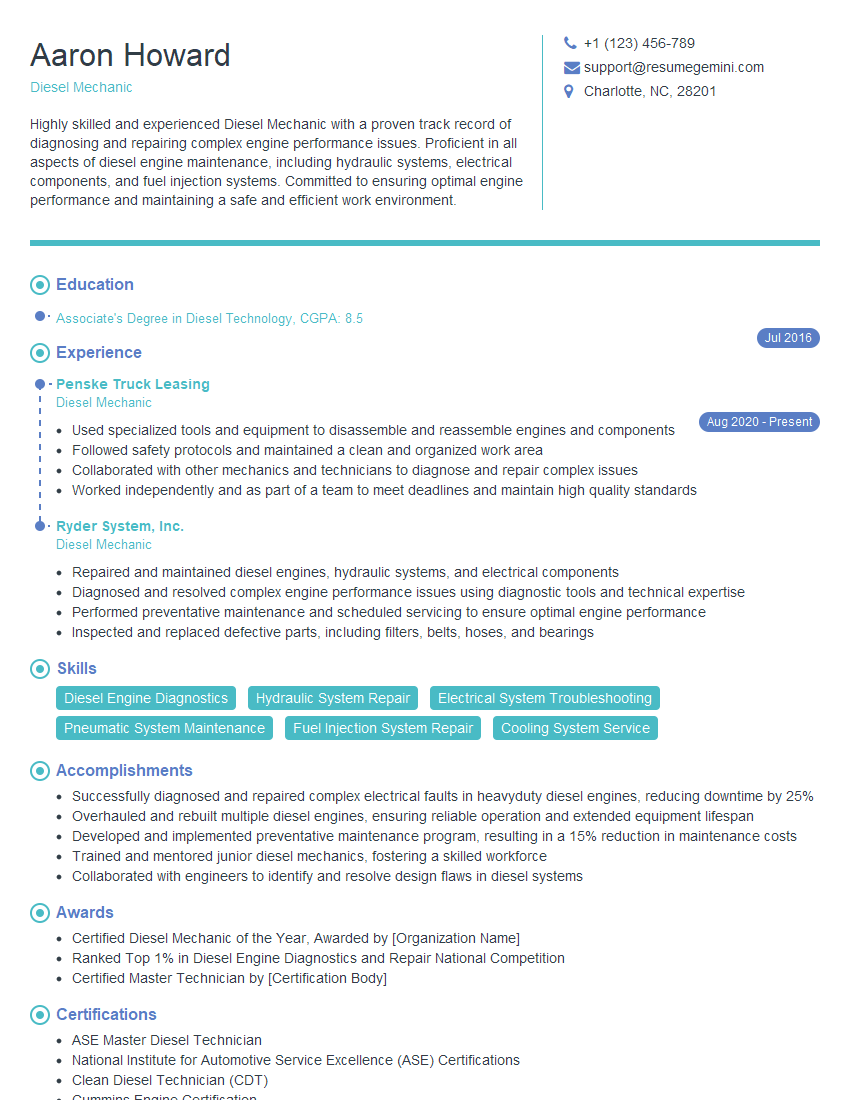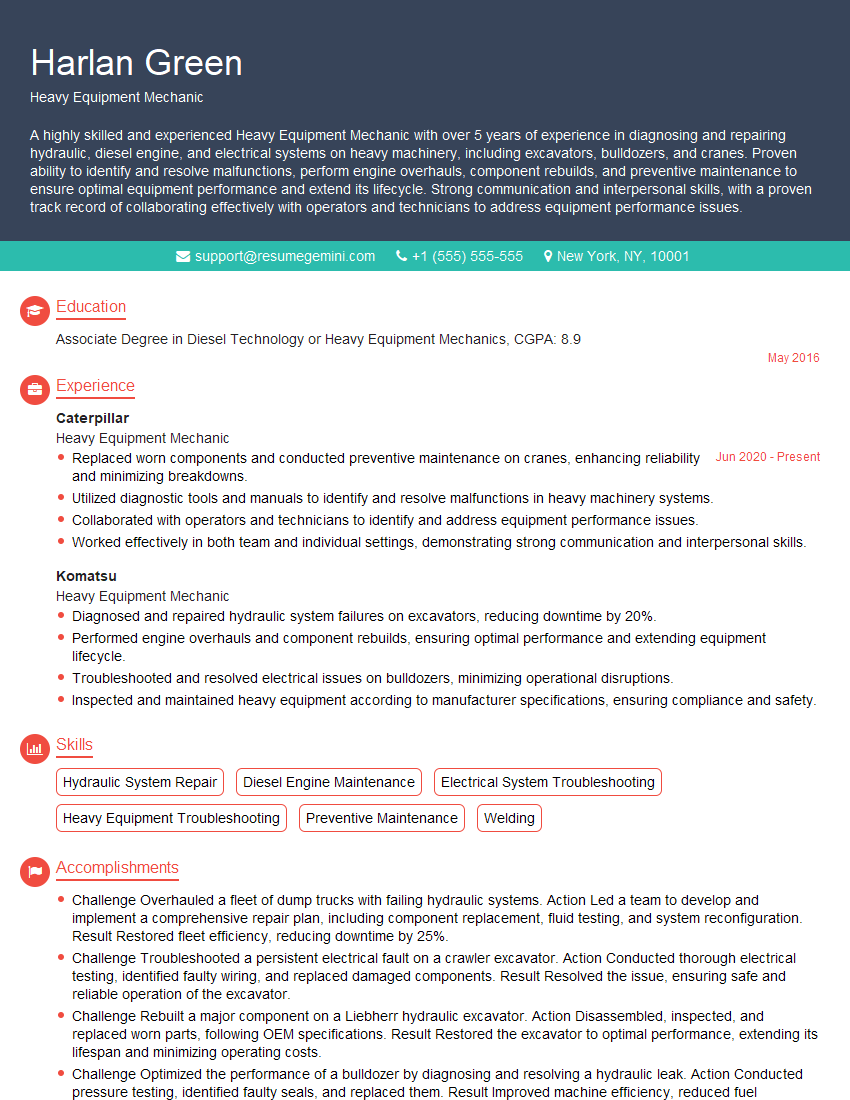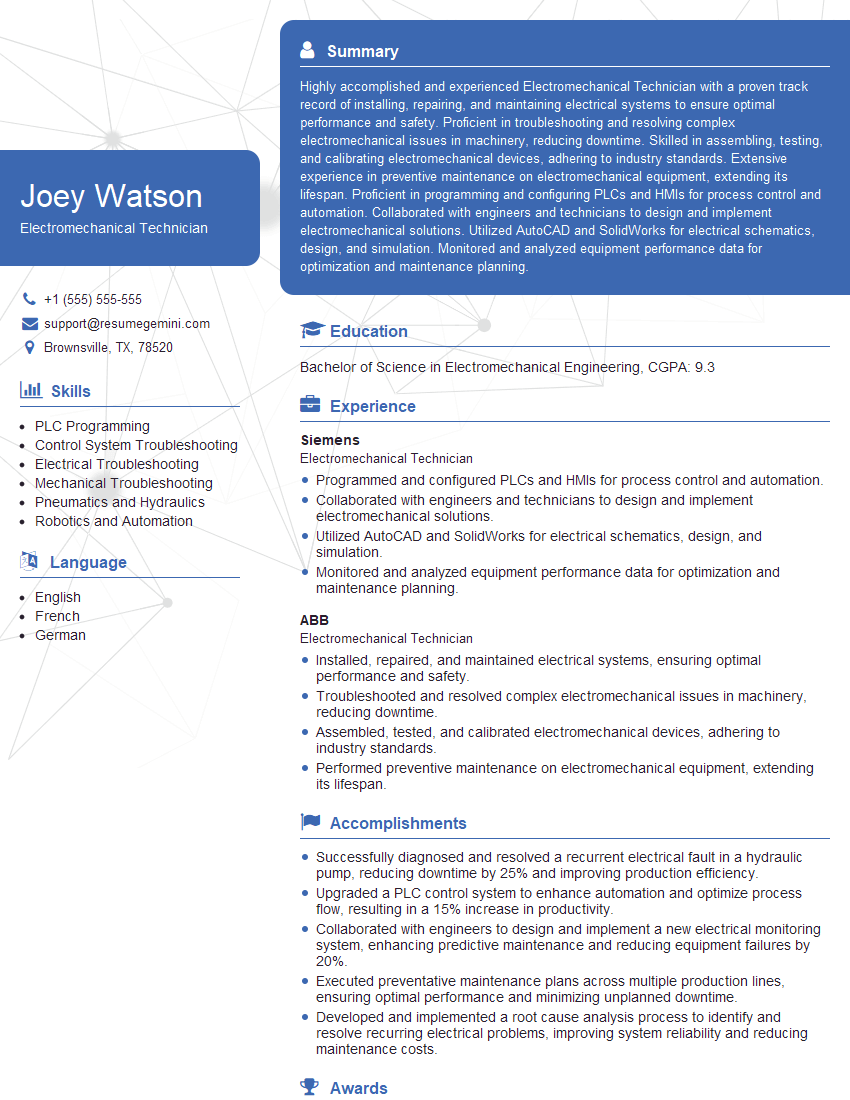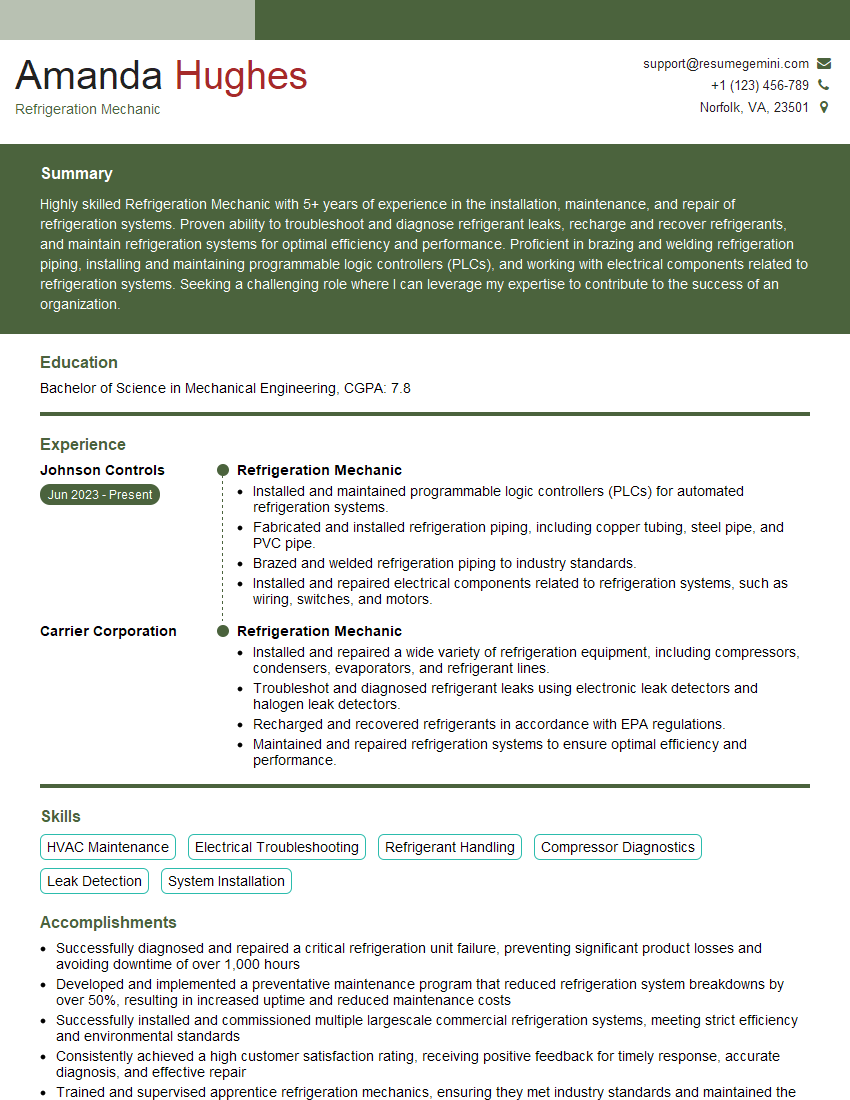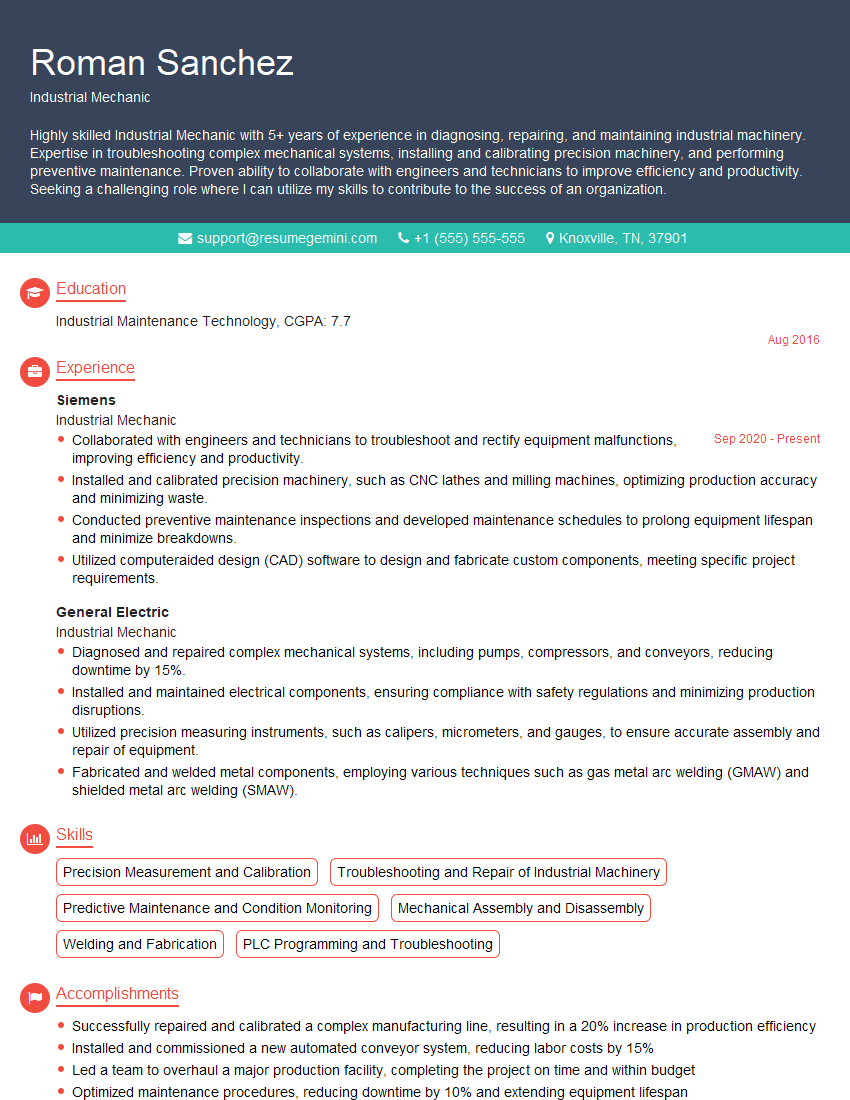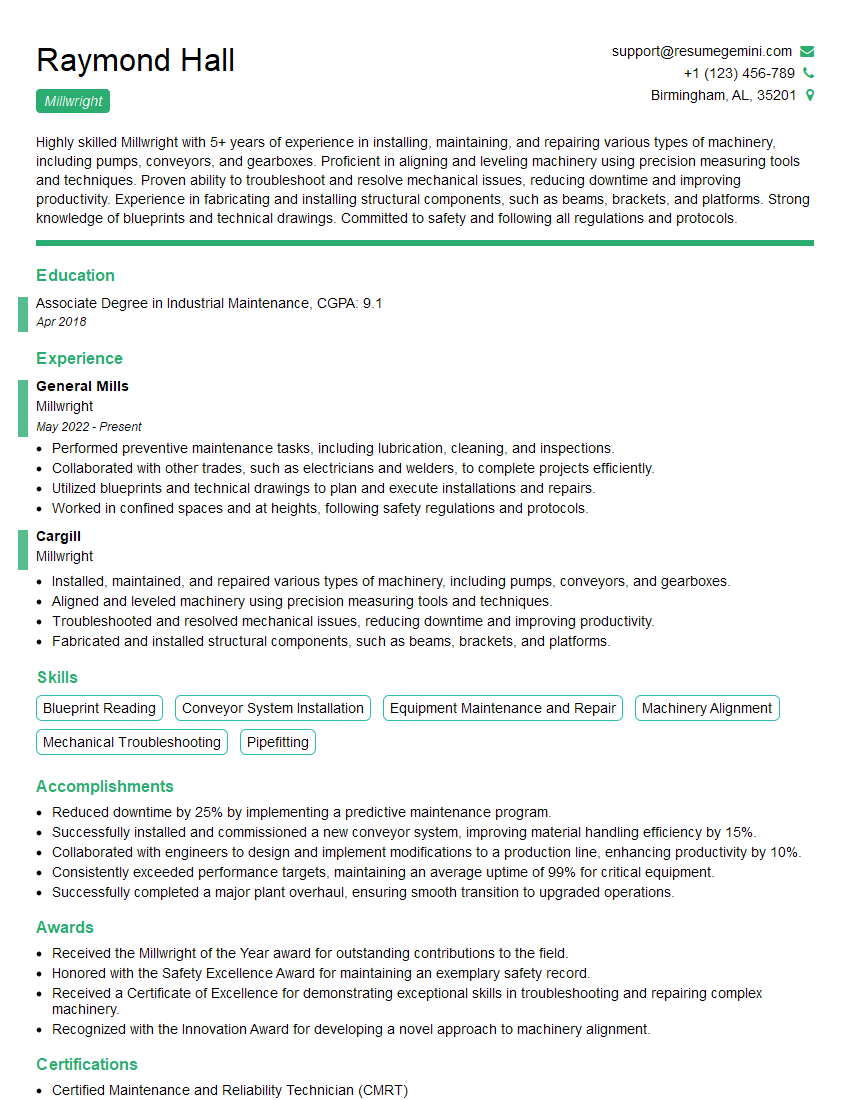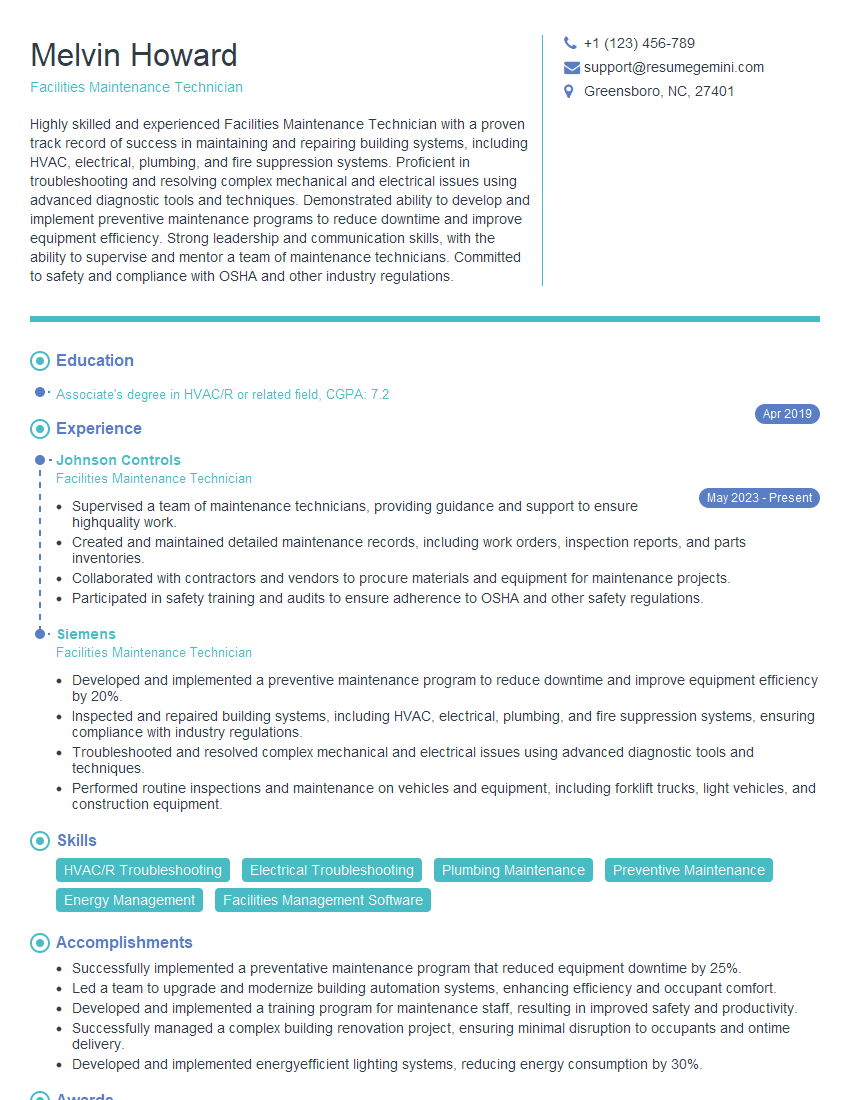Unlock your full potential by mastering the most common Repairing Machinery interview questions. This blog offers a deep dive into the critical topics, ensuring you’re not only prepared to answer but to excel. With these insights, you’ll approach your interview with clarity and confidence.
Questions Asked in Repairing Machinery Interview
Q 1. Describe your experience troubleshooting malfunctioning machinery.
Troubleshooting malfunctioning machinery is like detective work. You need to systematically gather clues to pinpoint the root cause of the problem. My experience spans various industrial machines, from conveyor belts and packaging equipment to CNC milling machines and robotic arms. I’ve tackled issues ranging from simple sensor failures to complex hydraulic leaks and control system malfunctions. For example, I once diagnosed a production line stoppage caused by a seemingly minor electrical fault in a proximity sensor, which was preventing the proper sequencing of robotic arm movements. The key is to systematically eliminate possibilities, using a combination of observation, testing, and knowledge of the machine’s design and operation.
Q 2. Explain your process for diagnosing mechanical failures.
My process for diagnosing mechanical failures follows a structured approach. First, I gather information: what’s the symptom? When did it start? What were the operating conditions? Then I visually inspect the machine, looking for obvious damage or irregularities. This is followed by a series of tests, starting with the simplest and progressing to more complex ones. For example, if a machine is not starting, I’d check the power supply, then fuses, before moving to more sophisticated diagnostics like checking motor windings or control circuits. I often use multimeters, oscilloscopes, and specialized diagnostic tools to pinpoint the fault. Documentation and diagrams are invaluable during this phase. Finally, once the problem is identified, I develop a repair strategy, ensuring the safety of both the machine and the personnel involved.
Q 3. What safety precautions do you follow when repairing machinery?
Safety is paramount. Before I even touch a machine, I perform a lockout/tagout procedure – this is crucial to prevent unexpected energy release. I always wear appropriate Personal Protective Equipment (PPE), including safety glasses, gloves, hearing protection, and steel-toed boots, depending on the task. I’m also meticulous about handling potentially hazardous materials like lubricants and coolants. I regularly assess the work area for potential hazards and ensure proper ventilation when working with chemicals or in confined spaces. My approach is grounded in the principles of risk assessment, and I always prioritize safety over speed.
Q 4. How do you prioritize repairs in a high-pressure environment?
Prioritizing repairs in a high-pressure environment requires a clear understanding of the impact of each malfunction. I use a system that weighs factors such as the severity of the problem, its impact on production, and the time required for the repair. Critical failures that halt production are prioritized first; minor issues that don’t affect output can be addressed later. For instance, a broken main drive motor would take precedence over a faulty indicator light. This process involves clear communication with operators and supervisors to ensure that everyone understands the repair schedule and its impact on the overall production plan.
Q 5. What experience do you have with preventative maintenance?
Preventative maintenance is key to minimizing downtime and extending the life of machinery. My experience includes developing and implementing preventative maintenance schedules, including regular inspections, lubrication, and component replacements. I’m familiar with various predictive maintenance techniques, such as vibration analysis and oil analysis, which help to identify potential problems before they cause major failures. For instance, I’ve implemented a system for tracking and managing the maintenance of a fleet of forklifts, resulting in a significant reduction in unexpected breakdowns and repair costs. The focus is on proactive measures to avoid costly and disruptive repairs.
Q 6. Describe your experience with hydraulic systems repair.
I have extensive experience repairing hydraulic systems. I understand the principles of hydraulic fluid dynamics, pump operation, and valve control. My experience ranges from diagnosing leaks and replacing seals to troubleshooting control system problems and rebuilding hydraulic pumps. I’m proficient in using diagnostic tools such as pressure gauges and flow meters to pinpoint problems. For example, I once repaired a hydraulic press that was experiencing inconsistent pressure due to a faulty pressure relief valve. Understanding the interaction of components within the hydraulic circuit is vital for successful repair.
Q 7. Explain your experience with pneumatic systems repair.
Pneumatic systems repair involves a good understanding of compressed air generation, distribution, and control. My experience covers troubleshooting air leaks, repairing pneumatic cylinders and valves, and resolving issues with pneumatic control systems. I’m familiar with various pneumatic components, including air filters, regulators, and lubricators, and I understand how to diagnose issues using tools such as pressure gauges and air flow meters. A recent example involved repairing a robotic arm malfunctioning due to a clogged air filter that was starving the pneumatic actuators of air. Maintaining the proper pressure and cleanliness of the air supply is crucial for reliable pneumatic system performance.
Q 8. What types of diagnostic tools are you proficient with?
My diagnostic tool proficiency spans a wide range, encompassing both basic and advanced equipment. I’m highly skilled in using multimeters for voltage, current, and resistance checks, crucial for pinpointing electrical faults. I’m also proficient with thermal imaging cameras to detect overheating components before they cause catastrophic damage – think of it like having X-ray vision for machinery! For more complex systems, I rely on oscilloscopes to analyze waveforms and identify intermittent issues within electronic control circuits. Furthermore, I utilize vibration analyzers to diagnose mechanical problems like bearing wear or imbalance in rotating machinery, often before they lead to a complete breakdown. Finally, I’m experienced using specialized diagnostic software provided by equipment manufacturers, interpreting the error codes and data logs to identify the root cause of failures.
- Multimeter: Used for basic electrical diagnostics like measuring voltage, current, and resistance.
- Thermal Imaging Camera: Detects heat signatures to identify overheating components.
- Oscilloscope: Analyzes electrical waveforms for precise diagnostics of electronic circuits.
- Vibration Analyzer: Measures vibrations to diagnose mechanical problems in rotating equipment.
- Manufacturer-Specific Diagnostic Software: Used to interpret error codes and data logs.
Q 9. How do you interpret technical manuals and schematics?
Interpreting technical manuals and schematics is fundamental to my work. I approach them systematically, starting with the overall system overview to understand how different components interact. Then, I delve into specific sections relevant to the problem at hand. I find cross-referencing diagrams with parts lists incredibly helpful, ensuring I’m working with the correct components and specifications. For example, if a hydraulic pump is failing, I’d locate the relevant schematic showing its connections to other parts of the system, its pressure readings, and operational sequence. Then I can trace the cause of failure, whether it’s a faulty component or a problem within the wider system, using the manual to identify the specific pressure settings or tolerances. I treat schematics as a roadmap, enabling me to navigate the machine’s inner workings and quickly pinpoint the source of malfunction. I consider myself proficient in reading both pneumatic and hydraulic schematics, which often rely on symbols and specific codes that require familiarity.
Imagine a complex engine schematic – it’s like a detailed map of a city. Understanding the pathways of fluids and signals is just like navigating the roads and public transport of that city. Each symbol represents a specific component or connection, and tracing them allows for effective troubleshooting.
Q 10. What is your experience with welding and fabrication?
My welding and fabrication skills are a significant asset. I’m proficient in various welding techniques, including MIG, TIG, and stick welding, and I am experienced in selecting the appropriate welding process and filler materials for different metals and applications. I’ve had experience creating custom brackets, mounting plates, and other structural components from raw materials for a variety of industrial equipment. Recently, I fabricated a custom support structure for a conveyor belt system that required careful consideration of load bearing and vibration resistance. My skills also extend to metal cutting and shaping using techniques like plasma cutting and grinding, which allows for quick and accurate modification of existing structures.
Think of it this way: sometimes a broken part can’t be simply replaced; it needs to be recreated. My welding and fabrication abilities allow me to do precisely that. I don’t just fix the existing; I can actually build or modify what I need.
Q 11. Describe your experience working with different types of motors.
My experience with motors encompasses a wide range of types and sizes, from small AC induction motors used in fans and pumps to larger DC servo motors used in robotics and precision machinery. I’m comfortable working with three-phase AC motors, understanding their starting mechanisms and troubleshooting common problems like winding faults or bearing wear. I also possess experience in maintaining and repairing DC motors, including brush replacement and commutator maintenance. My skills extend to troubleshooting issues with motor controllers, including variable frequency drives (VFDs). Working with VFDs, for instance, requires understanding their programming and parameters to optimize motor performance and ensure energy efficiency. I approach each motor repair with a focus on identifying the specific type of motor to ensure proper diagnosis and repair procedures are followed.
Each motor type has its own nuances. Understanding these nuances – like the differences in starting characteristics between AC induction and DC servo motors – allows me to approach troubleshooting efficiently and effectively.
Q 12. How do you handle unexpected equipment failures?
Unexpected equipment failures require a calm and methodical approach. My first step is to ensure safety: shut down the equipment to prevent further damage or injury. Then, I initiate a thorough assessment of the situation, gathering as much information as possible. This might involve checking the equipment’s control system, looking for error codes, or listening for unusual sounds. I utilize my diagnostic tools, such as multimeters and oscilloscopes, to pinpoint the root cause of the failure. Depending on the severity, I might attempt temporary repairs to restore limited functionality while prioritizing a more thorough solution. Effective communication with supervisors and maintenance staff is critical during such events. Once the issue is resolved, I make sure to document the problem, the solution implemented, and any preventative measures to be taken to minimize the risk of similar failures in the future.
Think of it like a detective solving a mystery. You have to gather clues, analyze the evidence, and follow a systematic approach to arrive at a solution.
Q 13. What is your experience with PLC programming and troubleshooting?
My PLC programming and troubleshooting experience involves working with several different brands and models of PLCs. I am proficient in ladder logic programming, understanding how to create and modify programs to control various industrial processes. My skills extend to troubleshooting PLC programs using monitoring tools to identify faulty logic or incorrect configurations. I have a strong understanding of input/output modules and their connection to field devices. I can diagnose communication failures, sensor problems, and actuator malfunctions by tracing signals from the PLC to the controlled equipment. For example, if a conveyor belt stops unexpectedly, I would systematically check the PLC program for faults, examine the input signals from sensors monitoring the belt’s status, and inspect the output signals to the motor controller.
Example Ladder Logic: // Simple ON/OFF control of a motor
IF (Start_Button) THEN
Motor_Output := TRUE;
ELSE
Motor_Output := FALSE;
END_IF;This code snippet illustrates a basic example of ladder logic, a key element in PLC programming that I regularly use for automation and control.
Q 14. Describe your experience with electrical systems repair.
My experience in electrical systems repair is extensive, covering a wide range of voltages and applications. I’m proficient in diagnosing and repairing faults in low-voltage control circuits, high-voltage power systems, and everything in between. I routinely handle tasks like replacing faulty components, such as circuit breakers, contactors, and relays. Troubleshooting wiring issues requires a methodical approach involving the use of multimeters and continuity testers to identify shorts, open circuits, or incorrect wiring. I’m also skilled at working with various types of electrical motors, including single-phase and three-phase motors, diagnosing issues such as bearing failure or stator winding problems. Moreover, my knowledge extends to understanding and troubleshooting electrical safety systems, like emergency stop circuits and lockout/tagout procedures.
Safety is paramount in electrical systems repair, and I consistently apply appropriate safety precautions. Every job begins with a thorough risk assessment, proper lockout/tagout procedures, and the use of appropriate personal protective equipment (PPE).
Q 15. What is your experience with bearing replacement and lubrication?
Bearing replacement and lubrication are fundamental aspects of machinery maintenance. My experience encompasses a wide range of bearing types, from simple ball bearings to complex tapered roller bearings used in high-speed applications. The process begins with a thorough assessment of the damaged bearing – identifying the cause of failure (e.g., wear, contamination, misalignment). This informs the selection of a replacement bearing with the correct specifications. Proper lubrication is crucial; I’m proficient in selecting the appropriate lubricant (grease or oil) based on the bearing type, operating conditions (temperature, speed, load), and manufacturer recommendations. The lubrication process itself involves ensuring complete coverage of the bearing surfaces, preventing contamination, and adhering to the manufacturer’s instructions regarding lubrication intervals. I’ve worked on numerous occasions replacing bearings in various machinery, from conveyor systems to CNC milling machines, always paying close attention to proper alignment and preload to ensure optimal performance and longevity. For instance, while working on a large industrial centrifuge, I meticulously measured the bearing housing alignment to within micrometers before installing the new bearings, resulting in smooth, vibration-free operation after the repair.
Career Expert Tips:
- Ace those interviews! Prepare effectively by reviewing the Top 50 Most Common Interview Questions on ResumeGemini.
- Navigate your job search with confidence! Explore a wide range of Career Tips on ResumeGemini. Learn about common challenges and recommendations to overcome them.
- Craft the perfect resume! Master the Art of Resume Writing with ResumeGemini’s guide. Showcase your unique qualifications and achievements effectively.
- Don’t miss out on holiday savings! Build your dream resume with ResumeGemini’s ATS optimized templates.
Q 16. How do you ensure the quality of your repairs?
Ensuring quality in my repairs is a multi-faceted process. It starts with a detailed diagnostic analysis to pinpoint the root cause of the malfunction, not just treating the symptom. I meticulously document all findings, including measurements, photographs, and observations. I then select high-quality replacement parts from reputable suppliers, verifying their specifications against the original equipment manufacturer’s (OEM) recommendations whenever possible. Throughout the repair process, I adhere to strict safety protocols and precision tolerances. I utilize calibrated measuring instruments and follow standardized repair procedures. Finally, after the repair is completed, I conduct thorough testing to verify the functionality and performance of the repaired machinery. This might involve functional tests, load tests, and performance measurements, all meticulously documented. If discrepancies exist, a thorough review is undertaken to pinpoint any inconsistencies. This commitment to quality assurance not only ensures that the machinery operates reliably and efficiently but also prevents future failures.
Q 17. Describe a time you had to repair a complex piece of machinery.
One particularly challenging repair involved a complex automated packaging machine that suddenly stopped functioning. The machine consisted of several interconnected subsystems: a conveyor belt, a robotic arm, a labeling system, and a sealing mechanism. The initial diagnosis pointed to a problem within the robotic arm’s control system. However, after meticulously investigating, it turned out the root cause was a minor but critical fault in the PLC (Programmable Logic Controller) program that controlled the synchronization between the conveyor and the robotic arm. This wasn’t immediately apparent as the PLC’s error logs were not informative. I had to carefully analyze the program code and trace the signal flow. Using a combination of technical manuals and my experience with PLC programming, I identified a timing error causing a sequence conflict. After correcting the program, carefully validating each change through simulation, and thoroughly testing the corrected program, the machine resumed its normal operation with no further issues. This experience emphasized the importance of systematic troubleshooting and the necessity of having a deep understanding of all aspects of a complex machine’s operation, from mechanical components to software controls.
Q 18. What is your experience with different types of machining processes?
My experience with machining processes is extensive, encompassing various techniques vital for repair and component fabrication. I’m proficient in milling, turning, drilling, grinding, and other processes. I have hands-on experience with both conventional and CNC (Computer Numerical Control) machining. Conventional machining, while requiring more manual skill, allows for flexibility in adapting to unique situations. CNC machining offers precision and repeatability vital for complex repairs or manufacturing of parts with tight tolerances. For instance, I’ve used CNC milling to create custom replacement parts that perfectly matched the specifications of worn components, ensuring a seamless fit and function. I understand the importance of selecting the appropriate machining technique based on material properties, required accuracy, and available equipment, and I adapt my skills to the task at hand. Knowledge of tool selection, cutting parameters, and post-processing is crucial, which is a skill I have honed over many years of experience.
Q 19. How do you maintain accurate records of repairs performed?
Accurate record-keeping is essential for traceability and accountability. I maintain detailed repair records using a combination of digital and physical methods. Each repair job starts with a work order that includes the machine’s identification, description of the fault, the planned actions, the parts used, and the time spent. I use a digital maintenance management system to log all these aspects. This system allows me to easily track progress and manage multiple jobs simultaneously. All steps are documented with photographs and measurements, creating a detailed history for each repair. Physical records, such as signed-off work orders and calibration certificates for measuring equipment, are also kept. This comprehensive approach ensures transparency and makes it easy to review past repairs for troubleshooting similar issues or for auditing purposes. This systematic approach guarantees detailed and readily accessible repair histories.
Q 20. What is your experience with various types of industrial machinery?
My experience spans a broad range of industrial machinery, encompassing various types and sizes. I’ve worked on equipment such as conveyors, pumps, compressors, packaging machines, CNC machines, injection molding machines, and more. This exposure has given me a solid understanding of the diverse challenges associated with repairing different types of machinery, from hydraulic and pneumatic systems to complex electromechanical systems. My expertise extends beyond just the mechanical aspects; I also possess a good understanding of electrical systems, control circuits, and programmable logic controllers (PLCs) that are commonly found in modern industrial machinery. Each piece of equipment presents unique challenges, requiring adaptability and a strong problem-solving approach. The experience I have gained allows me to easily adapt my skills to different machinery types and quickly identify potential issues.
Q 21. Describe your knowledge of different types of machine tools.
My knowledge of machine tools extends across a wide spectrum, from traditional lathes and milling machines to modern CNC machining centers. I understand the capabilities and limitations of each type of machine tool, including their applications, precision levels, and operating principles. I am familiar with the different types of cutting tools used, their geometry, material selection, and their impact on machining performance. I am also familiar with the safety precautions and procedures for operating these machines safely and effectively. For instance, I understand the differences in using a lathe for turning cylindrical components versus using a milling machine for shaping more complex geometries. My experience also includes using specialized machine tools such as grinders, EDM (Electrical Discharge Machining) machines, and laser cutters when necessary for specific repair tasks. This comprehensive knowledge enables me to select the most appropriate machine tools for any given repair job and to ensure its successful completion.
Q 22. What software programs are you proficient in for maintaining machinery?
Maintaining machinery requires proficiency in various software programs. My expertise lies primarily in Computerized Maintenance Management Systems (CMMS) like SAP PM and Maximo. These platforms allow for efficient tracking of equipment, scheduling preventative maintenance, managing work orders, and analyzing maintenance data. I’m also proficient in data analysis software like Microsoft Excel and Tableau, which are crucial for identifying trends and patterns in maintenance data to predict potential failures and optimize maintenance strategies. For example, using Excel, I can create pivot tables to analyze the frequency and cost of repairs for specific equipment, highlighting areas needing immediate attention or process improvements. Additionally, my experience includes using specialized software for specific machinery, such as the proprietary software used for controlling and monitoring Programmable Logic Controllers (PLCs) in automated systems.
Q 23. What is your experience with rotating equipment maintenance?
My experience with rotating equipment maintenance spans over eight years, encompassing various types of machinery like pumps, compressors, turbines, and motors. I’ve handled everything from routine inspections and lubrication to complex repairs and overhauls. One particularly challenging project involved diagnosing and resolving a recurring vibration issue in a high-speed centrifugal pump in a critical process. This involved meticulous data collection using vibration analyzers, coupled with thorough visual inspections. We discovered a misalignment in the pump coupling, which was causing excessive stress and vibration. Correcting the alignment resulted in a significant reduction in vibration levels and improved the pump’s efficiency and lifespan. I’m adept at using various diagnostic tools like vibration analyzers, thermal imaging cameras, and ultrasonic detectors to identify potential problems before they escalate into major failures.
Q 24. Explain your understanding of vibration analysis in machinery maintenance.
Vibration analysis is a crucial non-destructive technique used to detect and diagnose problems in rotating equipment. Essentially, we measure the vibrations produced by machinery to identify anomalies that might indicate a developing fault. Different types of vibrations can correspond to various issues, such as imbalance, misalignment, bearing wear, or looseness. For example, a high-frequency vibration might indicate a bearing problem, whereas a low-frequency vibration could point to misalignment. I use specialized equipment, such as handheld vibration meters and spectral analyzers, to collect vibration data. The data is then analyzed using software to identify specific frequencies and amplitudes, which are compared to baseline data and industry standards to pinpoint the root cause of the problem. This allows for proactive maintenance, preventing catastrophic failures and costly downtime.
Q 25. Describe your experience with root cause analysis in machinery failures.
Root cause analysis is a systematic approach to identifying the underlying causes of equipment failures, rather than just addressing the symptoms. I typically use techniques like the ‘5 Whys’ method, fault tree analysis, and fishbone diagrams. For instance, in a case where a conveyor belt repeatedly broke, I employed the ‘5 Whys’ method. By repeatedly asking ‘why’ after each answer (Why did the belt break? Because it was overloaded. Why was it overloaded? Because the feed rate was too high. Why was the feed rate too high? Because the sensor was malfunctioning. Why was the sensor malfunctioning? Because it wasn’t properly calibrated.), I identified the root cause – a faulty sensor requiring recalibration – instead of simply replacing the belt repeatedly. This approach ensures long-term solutions and prevents similar failures in the future. Proper documentation of the root cause analysis is crucial for implementing corrective actions and preventing recurrence.
Q 26. How do you manage your workload and prioritize tasks?
Managing workload and prioritizing tasks is critical in maintenance. I use a combination of methods, starting with a detailed review of all scheduled and unscheduled maintenance requests. I then prioritize tasks based on several factors: the criticality of the equipment (e.g., is it crucial for production?), the potential impact of failure, and the urgency of the repair. I utilize CMMS software to create detailed schedules and track progress, enabling me to manage multiple tasks simultaneously and meet deadlines effectively. I also practice effective time management techniques, such as breaking down large tasks into smaller, manageable steps, and utilizing time-blocking to allocate specific time slots for various activities. This approach ensures efficient resource allocation and maximizes uptime.
Q 27. What are your salary expectations?
My salary expectations are commensurate with my experience and skills, and I’m open to discussing a competitive compensation package that reflects my value to your organization. I’m confident that my expertise in machinery repair and maintenance will contribute significantly to your team’s success.
Q 28. Do you have any questions for me?
Yes, I have a few questions. I’d like to learn more about the specific types of machinery and equipment your company maintains, the size and structure of your maintenance team, and the company’s approach to preventive maintenance and continuous improvement initiatives. Understanding these aspects will help me assess how my skills and experience can best align with your needs and contribute to the overall success of your operations.
Key Topics to Learn for Repairing Machinery Interview
- Mechanical Principles: Understanding fundamental concepts like levers, gears, hydraulics, pneumatics, and thermodynamics is crucial for diagnosing and repairing machinery effectively. Consider how these principles apply in different machinery types.
- Electrical Systems: Familiarity with basic electrical circuits, troubleshooting electrical faults, motor control systems, and safety regulations related to electrical work is essential. Practice diagnosing common electrical problems in machinery.
- Diagnostic Techniques: Mastering systematic troubleshooting methods, using diagnostic tools (multimeters, oscilloscopes), interpreting error codes, and understanding preventative maintenance schedules are key skills. Develop your ability to identify the root cause of malfunctions efficiently.
- Specific Machinery Types: Depending on your target role, focus on the specific types of machinery you’ll be working with (e.g., industrial robots, CNC machines, agricultural equipment). Research their common malfunctions and repair procedures.
- Safety Procedures: Demonstrate a strong understanding of safety protocols, lockout/tagout procedures, personal protective equipment (PPE) usage, and hazard identification. This is paramount for any role in machinery repair.
- Blueprint Reading and Technical Manuals: Ability to interpret technical drawings, schematics, and maintenance manuals is crucial for understanding machinery design and carrying out repairs accurately. Practice interpreting different types of technical documentation.
- Welding and Fabrication (if applicable): If your role involves welding or fabrication, highlight your proficiency in different welding techniques and metalworking skills. Be prepared to discuss your experience and expertise.
Next Steps
Mastering the intricacies of Repairing Machinery opens doors to exciting career advancements and higher earning potential. A strong understanding of these concepts demonstrates your value to any employer. To significantly boost your job prospects, creating a well-structured, ATS-friendly resume is critical. ResumeGemini can help you craft a compelling resume that highlights your skills and experience effectively. Take advantage of their resources and review the examples of resumes tailored to Repairing Machinery they provide to gain a competitive edge in your job search.
Explore more articles
Users Rating of Our Blogs
Share Your Experience
We value your feedback! Please rate our content and share your thoughts (optional).
What Readers Say About Our Blog
good

